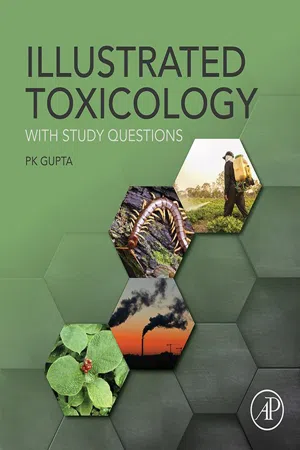
Illustrated Toxicology
With Study Questions
P.K. Gupta
- 630 páginas
- English
- ePUB (apto para móviles)
- Disponible en iOS y Android
Illustrated Toxicology
With Study Questions
P.K. Gupta
Información del libro
Illustrated Toxicology: With Study Questions is an essential, practical resource for self-study and guidance catering to a broad spectrum of students. This book covers a range of core toxicological areas, including pesticides, radioactive materials and poisonous plants, also presenting a section on veterinary toxicology. Across 16 chapters, the book presents key concepts with the aid of over 250 detailed, full-color illustrations. Each section is supplemented with practical exercises to support active learning. This combination of clear illustrations and sample testing will help readers gain a deeper understanding of toxicology.
This book is useful for toxicology, pharmacy, medical and veterinary students, and also serves as a refresher for academics and professionals in the field, including clinical pharmacists, forensic toxicologists, environmentalists and veterinarians.
- Includes comprehensive coverage of key toxicological concepts for study and revision
- Provides a visual learning aid with over 250 full-color illustrations
- Enhances understanding and memory retention of core concepts with the use of practical exercises
Preguntas frecuentes
Información
General toxicology
Abstract
Keywords
1.1 Definitions and Subdisciplines of Toxicology
- Q. Definition
The traditional definition of toxicology is “the science of poisons.” As our understanding of how various agents can cause harm to humans and other organisms, a more descriptive definition of toxicology is “the study of the adverse effects of chemicals or physical agents on living organisms.”
Explanation: The word “toxicology” is derived from the Greek word “toxicon” which means “poison” and logos means to study. It also includes study of special effects of toxicants developmental toxicity, teratogenicity, carcinogenicity, mutagenesis, immune-toxicity, neurotoxicity, endocrine disruption, etc. Adverse effects may occur in many forms, ranging from immediate death to subtle changes not realized until months or years later. They may occur at various levels within the body, such as an organ, a type of cell, or a specific biochemical. Knowledge of how toxic agents damage the body has progressed along with medical knowledge. It is now known that various observable changes in anatomy or body functions actually result from previously unrecognized changes in specific biochemicals in the body. - Q. Define xenobiotics.
Xenobiotic: Xenobiotics (xeno is a Greek word which means “strange or alien”) are the substances which are foreign to the body and are biologically active. These cannot be broken down to generate energy or be assimilated into a biosynthetic pathway. It is a very wide class and structurally adverse agents, both natural and synthetic chemicals such as drugs, industrial chemicals, pesticides, alkaloids, secondary plant metabolites and toxins of molds, plants and animals, and environmental pollutants. - Q. What are the subdisciplines of toxicology?
- Biochemical toxicology
- Reproductive toxicology
- Development toxicology
- Teratology
- Genetic toxicology
- Clinical toxicology
- Forensic toxicology
- Analytical toxicology
- Nutritional toxicology
- Veterinary toxicology
- Environmental toxicology
- Occupationa...